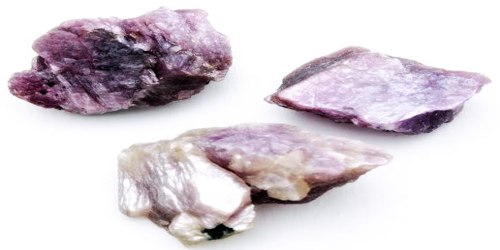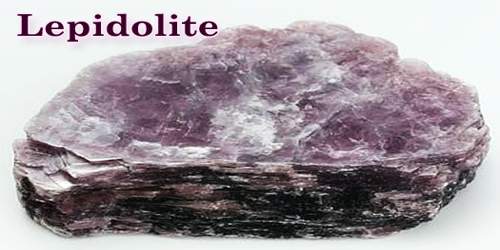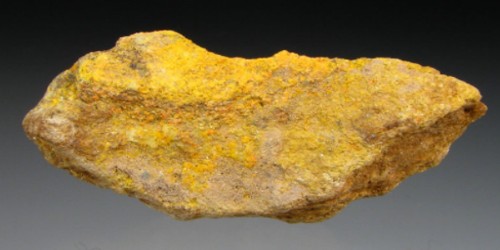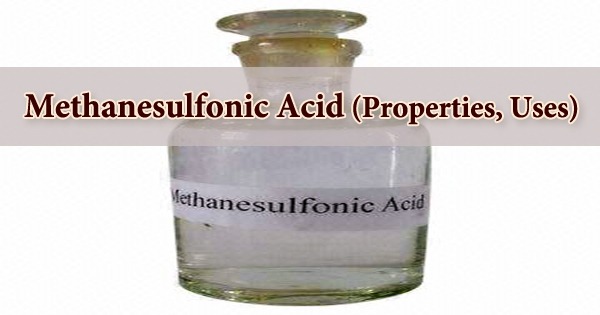Definition –
Lepidolite is one of the most powerful crystals, which is a lilac-gray or rose-colored member of the mica group of minerals with formula K(Li,Al,Rb)2(Al,Si)4O10(F,OH)2. It is the most abundant lithium-bearing mineral and is a secondary source of this metal. It is a phyllosilicate mineral and a member of the polylithionite-trilithionite series. Lepidolite is part of a three-part series consisting of polylithionite, lepidolite, and trilithionite. All three minerals share similar properties and are caused because of varying ratios of lithium and aluminum in their chemical formulas. The Li:Al ratio varies from 2:1 in polylithionite up to 1.5:1.5 in trilithionite.
Lepidolite is the most common lithium-bearing mineral and serves as a minor ore of lithium metal, with rubidium and cesium sometimes being byproducts. When impregnated with quartz, lepidolite is used as a minor gemstone. Flakes of lepidolite are sometimes responsible for the color of pink and red aventurine.
Found in California, Lepidolite is created amongst other minerals such as Tourmaline, Morganite, Hiddenite and Kunzite, often with some of the same traits. Lepidolite is found naturally in a variety of colors, mainly pink, purple, and red, but also gray and, rarely, yellow and colorless. Because lepidolite is a lithium-bearing mica, it is often wrongly assumed that lithium is what causes the pink hues that are so characteristic of this mineral. Instead, it is trace amounts of manganese that cause the pink, purple, and red colors.
Lepidolite enhances self-love and optimism with patience. It is wonderful for dreamwork as well as dream recall. Lepidolite is known to clear out all of the redundant messages and voices from the past that hold us back from happiness and/or success. It will aid in attracting supportive friends and colleagues, as well as bring opportunities to succeed. It will help any and all living in unavoidably stressful experiences (such as city dwellers) to maintain a calm, and serene center.

Occurrence and Properties of Lepidolite –
Lepidolite occurs in granite pegmatites, in some high-temperature quartz veins, greisens, and granites. Associated minerals include quartz, feldspar, spodumene, amblygonite, tourmaline, columbite, cassiterite, topaz, and beryl. Notable occurrences include Brazil; Ural Mountains, Russia; California, United States; Tanco Mine, Bernic Lake, Manitoba, Canada; and Madagascar.
Lepidolite can only form in geochemical environments where high concentrations of lithium are available for mineral formation. Lepidolite is a rare mineral because these geochemical situations rarely occur. It is associated with other lithium-bearing minerals like spodumene in pegmatite bodies. It is one of the major sources of the rare alkali metals rubidium and caesium.
In 1861, Robert Bunsen and Gustav Kirchhoff extracted 150 kg (330 lb) of lepidolite and yielded a few grams of rubidium salts for analysis, and therefore discovered the new element rubidium.
Lepidolite is mica, a group of glittery silicate minerals. It is sometimes found as an inclusion in tourmaline and quartz, giving a bit of shine to those stones. It is soft, a 2.5-3 on the Mohs scale. In its raw form, it can be scaly, with pieces that flake off. It can be translucent and has a pearly luster. It is most often found in shades of purple, pink and lilac, although it can also be found in gray or yellow. It is so high in lithium it is actually mined as a source of lithium, and is sometimes called “lithium mica”.
Most specimens of lepidolite have pink, red or purple as their dominant hue. These are the expected colors of lepidolite. The mineral sometimes has a dark tone, which gives it a grayish appearance. Rare specimens of lepidolite are colorless or yellow. Many people assume that lithium produces the color of lepidolite; however, lithium rarely serves as a chromophore in minerals. Manganese is the cause of color in pink, red and purple lepidolites.
Lepidolite will strengthen the immune system, It relieves allergies, exhaustion. It is detoxifier for the skin and connective tissue. It is an excellent stone for menopause, especially as an elixir. It is a very powerful agent for emotionally calming and healing. Laid directly on the painful areas of the body, it is said to help reduce nerve pain, sciatica, neuralgia, and some joint issues. It may also reduce the ill-effects of dependency on such things as alcohol, medication, tobacco, food, or emotional obsession as well.
Uses and Benefits of Lepidolite –
Lepidolite actually used to locate the site of the body’s disease or blockage, vibrating gently to indicate the source. It is sometimes used to increase spirituality, or increase the desire to seek spirituality. Carried often as a touchstone, simply due to it’s calming properties, it is also known to attract good luck, and drive off negativity although it protective qualities are not superior.
The most important use of lepidolite has been as a minor ore of lithium metal. This use was more important in the first half of the 1900s than it is today. Today most lithium is produced from brine and evaporite deposits in South America, where lithium can be extracted more economically. Small amounts of rubidium sometimes substitute for lithium in the lepidolite crystal lattice. When present, the rubidium can be recovered as a byproduct during the extraction of lithium. Lepidolite and pollucite, another lithium mineral that can contain significant amounts of cesium, often occur together. These minerals can be mined for lithium with cesium as a byproduct.
Lepidolite opens people’s crown chakra to receive higher guidance, helping them see their struggles from a wider perspective and find the lessons they contain. It can help lift people out of depression or express the grief that lies beneath its surface. Lepidolite shows us that healing begins once we accept our shadows and sorrows as pieces of ourselves to love rather than resist. Lepidolite is a good stone to meditate with, especially when people are feeling the rise of strong emotions. Hold or wear one while they close their eyes, take a few deep breaths, and ask their guides to help them open up to the higher guidance they offer.
Lepidolite is also an important ingredient in the quartz gem known as “aventurine”. The aventure scence and color of pink, red, and purple aventurine is often caused by the presence of tiny flakes of lepidolite within the quartz. Just a few weight percent of lepidolite flakes can be enough to impart a distinct color in aventurine.
Information Sources:
















